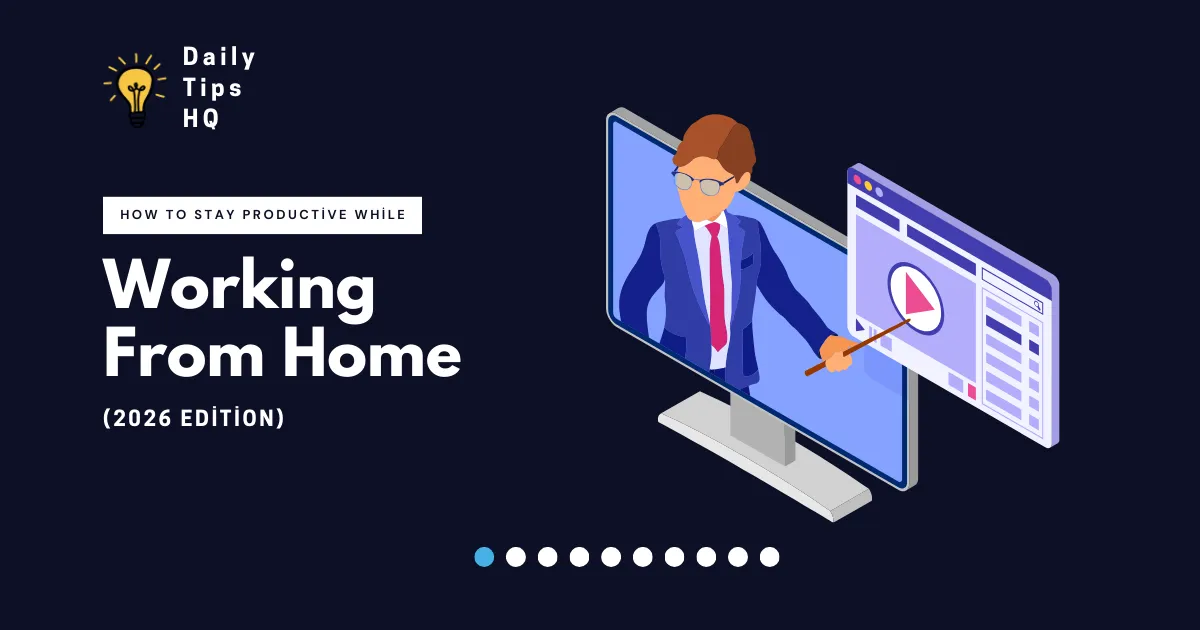💡 Introduction
Working from home sounds like a dream—until you find yourself still in pajamas at 3 PM, distracted by laundry and suddenly obsessed with reorganizing the kitchen. If you want to be productive while working remotely, you need structure, mindset shifts, and a few proven systems in place.
This guide covers practical strategies you can implement today to avoid burnout, stay focused, and thrive in your remote environment.
🧱 1. Build a Dedicated Workspace
Your bed is for sleeping, not for spreadsheets. Set up:
-
A desk and chair (preferably ergonomic)
-
Good lighting (natural if possible)
-
Noise-cancelling headphones
-
A clear “work zone” with minimal clutter
✅ Bonus Tip: Avoid working from places associated with relaxation (like the couch) to signal your brain into “work mode.”
⏰ 2. Stick to a Daily Routine
Structure brings freedom. Try:
-
Consistent start time
-
Morning ritual (coffee, journaling, 5-min walk)
-
Set lunch & break times
-
Clear end-of-day shutdown ritual
🧠 Consistency = momentum. If you wake up “whenever,” your brain stays foggy longer.
📵 3. Master Distraction Management
Distractions are productivity killers. You can’t control every interruption—but you can control your environment:
-
Use apps like Focus To-Do, Freedom, or Cold Turkey
-
Turn off non-work notifications
-
Set Do Not Disturb hours
-
Let household members know your focused hours
🍅 4. Use the Pomodoro Technique (25:5 Rule)
The famous Pomodoro method is perfect for home environments.
-
Work for 25 minutes
-
Break for 5 minutes
-
Repeat x4
-
Take a longer break (15–30 minutes)
This boosts focus stamina while giving your brain scheduled downtime.
🎯 5. Set Clear Daily Goals
Avoid the “what should I do now?” trap by starting each day with:
-
A top 3 priorities list
-
Estimated time per task
-
A “done” list to track wins
-
Optional: Use tools like Trello, Notion, or Todoist
🪞 6. Leverage Accountability Mirrors
Remote work can feel isolating. Create accountability through:
-
Daily standup buddy (check in with a peer or friend)
-
Share weekly goals on LinkedIn or X (formerly Twitter)
-
Use a time tracker like Toggl or Clockify
🧘 7. Prioritize Mental and Physical Health
Burnout is real when you’re always “on” at home. Try:
-
30-minute movement (stretching, walking, bodyweight workouts)
-
Regular water + meal breaks
-
5–10 minute meditation apps: Calm, Headspace, Insight Timer
-
Mid-day sunlight exposure
🎧 8. Use Background Sound to Trigger Focus
Experiment with:
-
Lo-fi beats (YouTube: “Lofi Girl”)
-
White noise or rain (Noisli, MyNoise.net)
-
Binaural beats for deep focus (Spotify/YouTube)
Find what works for you and make it a habit.
💡 9. Batch Similar Tasks
Multitasking is a myth. Instead:
-
Group similar tasks (emails, calls, admin)
-
Dedicate blocks of time per category
-
Use “theming” (e.g., Mondays = planning, Fridays = deep work)
🔚 10. Log Off with Purpose
Working from home shouldn’t feel like living at work. Set boundaries:
-
Shut your laptop
-
Turn off Slack/Email
-
Move physically away from your work zone
-
Reflect: “What did I achieve today?”
🧠 Pro Tips for Advanced Productivity
-
Use a second monitor to reduce tab-hopping
-
Try time blocking your entire day
-
Keep a “parking lot” list for ideas that pop up mid-task
-
Review your week every Friday
🙋♀️ FAQ
❓ Why is it hard to be productive at home?
Because your home is full of non-work triggers—TV, chores, snacks, kids. Without clear environmental cues and routines, your brain defaults to relaxation mode.
❓ How can I stop feeling lazy when working from home?
Design a structured day, get dressed (even casually), use productivity systems (like Pomodoro), and track small wins to keep momentum.
❓ Does having a dedicated home office really matter?
Yes. Even if it’s a corner of your room, having a designated workspace trains your brain to enter “work mode” when you sit down.
❓ Should I use productivity apps?
Absolutely! Apps like Toggl, Notion, Forest, and RescueTime can track focus, block distractions, and keep you accountable.
❓ Can I be more productive remotely than in the office?
With the right setup, many people are more productive at home, thanks to fewer meetings, less commuting, and personalized environments.
🔗 Related Articles
👉 Remote Work 101: Everything You Need to Know
👉 How to Avoid Burnout While Working Remotely

